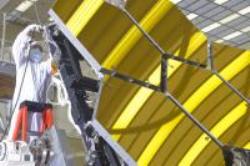Cryogenic testing for the last six primary mirror segments and a secondary mirror has been accomplished, and is all set to take wings on NASA's James Webb Space Telescope. This achievement demonstrates the successful climax of an extended development process, and finally launched for the production and analysis of large mirrors.
 NASA webb telescope mirror
NASA webb telescope mirror
The Webb telescope consists of 21 mirrors and 18 mirror segments combined together to form an extensive 21.3 ft primary mirror. Each mirror segment has been examined individually for its effective operation at a temperature of 40 K.
Series of analysis was carried on for a period of 10 weeks, and was successfully completed at the X-ray and Cryogenic Facility (XRCF) at NASA's Marshall Space Flight Center in Huntsville, Ala. The analysis included the process of freezing of primary mirror segments to -379 ° F. Throughout the two test cycles, the telescope engineers executed precise calculations based on the effect of cold on the property of mirror, especially its shape. Evaluations exhibited the fact that the effect of temperature altered the shape of each mirror as predicted. At maximum cold temperature and deep space, each mirror will be of the right shape.
Ball Aerospace and Technologies has accomplished comparable testing with the secondary mirror. However, secondary mirror failed to converge light into a focus due to its convexity. The process of the analysis of mirror offers challenges and more complex optical measurements.
The Webb telescope is an advanced space observatory and successor to the Hubble Space Telescope. It will be the robust space telescope ever constructed. It presents the images of the nascent galaxies, discovers planets in the region of distant stars. It is a combined project of NASA, the Canadian Space Agency, and the European Space Agency.